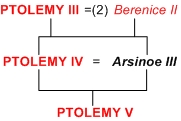
Arsinoe III1, daughter of Ptolemy III and Berenice II2, probably born between November 246 and June 2453, probably declared princess (basilissa) at birth4, married her brother Ptolemy IV, king of Egypt, in or before Thoth Year 3 = 17 October - 15 November 2205, by whom she had one child, Ptolemy V6, incorporated in the dynastic cult with Ptolemy IV in Year 7 (Mac.) = 216/5 as the Fatherloving Gods, Qeoi FilopatwreV7, possibly repudiated by Ptolemy IV late summer 2048, probably died late summer 204, allegedly murdered by Philammon as an agent for Sosibius, or by Ptolemy IV himself, possibly burnt to death in a palace fire9, and posthumously honoured from Ptolemy V year 7 = 199/8 onwards by a priestess in the dynastic cult at Alexandria10.
[1] PP VI 14492. Gr: Arsinoh Filopatwr. There is some confusion about her name. The fact that Arsinoe was her birth-name is proven by the inclusion of this name amongst the children of Ptolemy III listed in the exedra of Thermos (IG IX, I, I2, 56d). Livy 27.4 calls her Cleopatra (PP VI 14514), which is explicable as this was the standard name assumed by queens of the later dynasty. More puzzlingly, Justin 30.1 calls her Eurydice (PP VI 14510). Even though Justin has a well-deserved reputation for carelessness, the reason for this apparent mistake is not obvious, since there is no prominent Eurydice in the period and it is a name of no legitimising significance for the dynasty. Ý
[2] Polybius 15.25.2. Paternity is confirmed by the exedra of Thermos (IG IX, I, I2, 56d). Ý
[3] See discussion under her brother Magas. Ý
[4] She has this title on the exedra of Thermos (IG IX, I, I2, 56d), and according to the Decree of Canopus (OGIS 56) her sister Berenice, who also has the title on the exedra, received it at birth. Since the presence of Berenice on the exedra shows that it was erected before or very shortly after Berenice's death in March 238, Arsinoe was at most a few years old at that time. Therefore it is almost certain that she too received the title at birth. Ý
[5] pdem. Vatic. 2037B, wherein the rulers are already referred to as "the father-loving gods". This reference used to be considered an error for "the father-loving god" made by the original editor, A Mai (Catalogo de' papiri egiziani della Biblioteca Vaticana 24(e)). It was generally held that the couple were not married at the time of the battle of Raphia, 10 Pachon Year 5 = 22 June 217, since Polybius 5.83 and III Maccabees 1.1 describe her simply as his "sister" in their accounts of the battle, but that they married shortly thereafter, since she is described in the Raphia Decree as his queen. This decree (see E. R. Bevan, The House of Ptolemy 388, n. to p. 232) is dated 1 Phaophi year 6 = 15 November 217. However, stele Vienna 153 records the death of the High Priest of Ptah Amenhor II on 26 Pharmouthi Year 5 = 8 June 217, and gives him, inter alia, the title "priest of the father-loving gods" -- see J. Quaegebeur (JNES 30 (1971) 239, 248 n. 60). E. Lanciers, AfP 34 (1988) 27, pointed out that this effectively rehabilitated Mai's reading. Ý
[6] Justin 30.2 (calling her "Eurydice"). Ý
[7] See discussion under Ptolemy IV. Ý
[8] John of Antioch (FGrH IV 558 F54). Ý
[9] Polybius 15.25.2. Justin 30.1. See discussion of the death of Ptolemy IV. Ý
[10] For a list of the priestesses of Arsinoe Philopator as known in 1983, see W. Clarysse & G. van der Veken, The Eponymous Priests of Ptolemaic Egypt. Unlike the canephore and athlophore, to both of whom she was inferior in status, the priestess had no special title, and the appointment was not changed annually. Ý
Update Notes:
10 Feb 2002: Added individual trees
21 Feb 2002: Split into separate entry
18 May 2003: Added Xrefs to the Lacus Curtius edition
of Polybius
23 Aug 2003: Added Xrefs to online Justin
23 Oct 2003: Added Xref to onlinetranslation of
Canopus Decree
11 Mar 2005: Added Greek transcription
14 Sep 2006: Added links to Packhard Humanities DB
Website © Chris Bennett, 2001-2011 -- All rights reserved